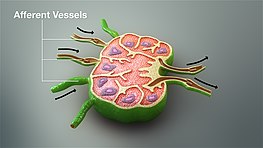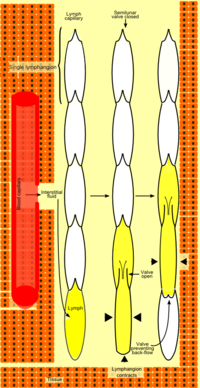Lymphatic vessel
This article needs additional citations for verification. (April 2010) |
| Lymphatic vessel | |
|---|---|
Lymph capillaries in the tissue spaces. | |
 The thoracic duct and right lymphatic duct. | |
| Details | |
| System | Lymphatic system |
| Identifiers | |
| Latin | vas lymphaticum |
| MeSH | D042601 |
| TA98 | A12.0.00.038 |
| TA2 | 3915 |
| TH | H3.09.02.0.05001 |
| FMA | 30315 |
| Anatomical terminology] | |

The lymphatic vessels (or lymph vessels or lymphatics) are thin-walled vessels (tubes), structured like
The vessels that bring lymph away from the tissues and towards the lymph nodes can be classified as
Structure
The general structure of lymphatics is based on that of
The lymphatic conducting system broadly consists of two types of channels—the initial lymphatics, the prelymphatics or lymph capillaries that specialize in collection of the lymph from the interstital fluid, and the larger lymph vessels that propel the lymph forward.
Unlike the cardiovascular system, the lymphatic system is not closed and has no central pump. Lymph movement occurs despite low pressure due to

Lymph capillaries
The lymphatic circulation begins with blind ending (closed at one end) highly permeable superficial lymph capillaries, formed by endothelial cells with button-like junctions between them that allow fluid to pass through them when the interstitial pressure is sufficiently high.
Rhythmic contraction of the vessel walls through movements may also help draw fluid into the smallest lymphatic vessels, capillaries. If tissue fluid builds up the tissue will swell; this is called edema. As the circular path through the body's system continues, the fluid is then transported to progressively larger lymphatic vessels culminating in the right lymphatic duct (for lymph from the right upper body) and the thoracic duct (for the rest of the body); both ducts drain into the circulatory system at the right and left subclavian veins. The system collaborates with white blood cells in lymph nodes to protect the body from being infected by cancer cells, fungi, viruses or bacteria. This is known as a secondary circulatory system.
Lymph vessels
The lymph capillaries drain into larger collecting lymphatics. These are contractile lymphatics which transport lymph using a combination of smooth muscle walls, which contract to assist in transporting lymph, as well as valves to prevent the lymph from flowing backwards.
Lymph vessels consist of functional units known as lymphangions which are segments separated by semilunar valves. These segments propel or resist the flow of lymph by the contraction of the encircling smooth muscle depending upon the ratio of its length to its radius.[7]
Function
Lymph vessels act as reservoirs for plasma and other substances including cells that have leaked from the vascular system and transport lymph fluid back from the tissues to the circulatory system. Without functioning lymph vessels, lymph cannot be effectively drained and lymphedema typically results.
Afferent vessels
The afferent lymph vessels enter at all parts of the periphery of the
Afferent lymphatic vessels are only found in lymph nodes. This is in contrast to efferent lymphatic vessel which are also found in the thymus and spleen.
Efferent vessels
The efferent lymphatic vessel commences from the
Efferent lymphatic vessels are also found in association with the thymus and spleen. This is in contrast to afferent lymphatic vessels, which are found only in association with lymph nodes.
Clinical significance
Lymphedema is the swelling of tissues due to insufficient fluid drainage by the lymphatic vessels. It can be the result from absent, underdeveloped or dysfunctional lymphatic vessels. In hereditary (or primary) lymphedema, the lymphatic vessels are absent, underdeveloped or dysfunctional due to genetic causes. In acquired (or secondary) lymphedema, the lymphatic vessels are damaged by injury or infection.[8][9] Lymphangiomatosis is a disease involving multiple cysts or lesions formed from lymphatic vessels.
See also
Additional images
-
Lymphatic system
-
Section across portal canal of pig. X 250.
References
- ^ "19.2B: Distribution of Lymphatic Vessels". Medicine LibreTexts. 22 July 2018. Retrieved 28 November 2021.
- PMID 14581448.
- ^ PMID 16597644.
- ^ PMID 17846148.
- PMID 23980683.
- ^ ISBN 0-397-51256-2.
- ISBN 0-7803-8439-3.
- S2CID 5899689.
- ^ Krebs R, Jeltsch M (2013). "The lymphangiogenic growth factors VEGF-C and VEGF-D. Part 2: The role of VEGF-C and VEGF-D in lymphatic system diseases". Lymphologie in Forschung und Praxis. 17 (2): 96–104.
Further reading
- Nosek TM. "Role of Lymphatic Vessels". Essentials of Human Physiology. Archived from the original on 2016-03-24.
External links
- Lymphatic+Vessels at the U.S. National Library of Medicine Medical Subject Headings (MeSH)
- Efferent lymph vessel[dead link] - BioWeb at University of Wisconsin System


